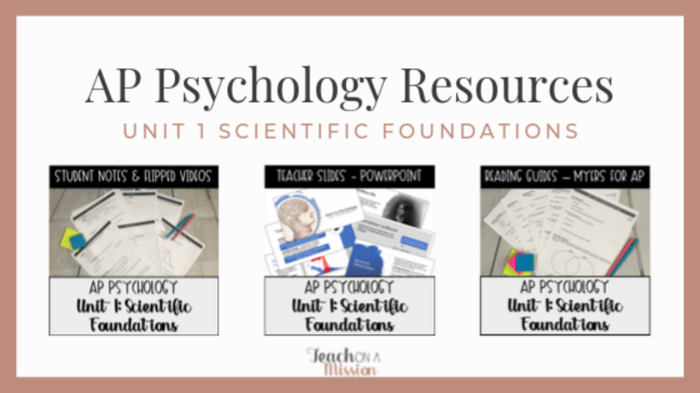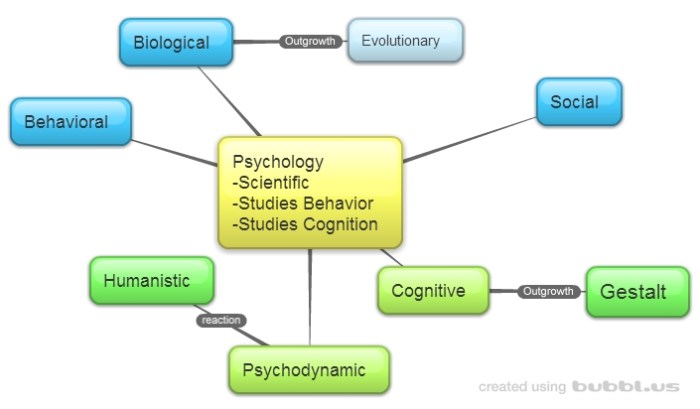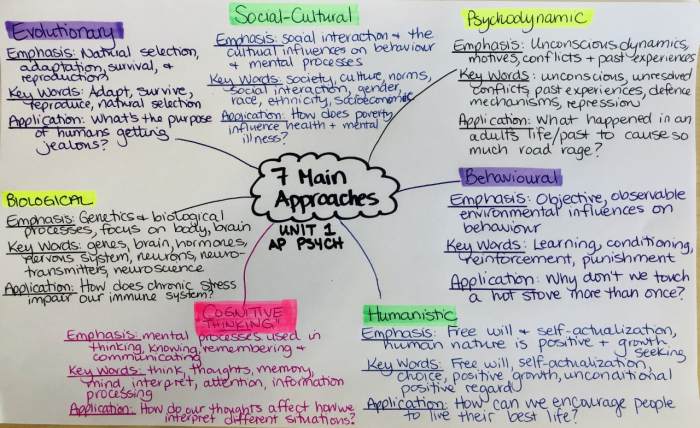Welcome to AP Psychology Unit 1 Vocabulary, an indispensable resource that will empower you to navigate the intricate world of psychology. This comprehensive guide provides clear and concise definitions of key terms, setting a solid foundation for your understanding of this fascinating subject.
Throughout this guide, you’ll explore the core concepts of psychology, delve into the biological bases of behavior, and unravel the mysteries of sensation and perception. Prepare to expand your vocabulary and enhance your comprehension of the human mind and behavior.
Core Concepts of Psychology

Psychology is the scientific study of behavior and mental processes. It seeks to understand the complex interactions between our thoughts, feelings, and actions, and how these influence our behavior.
There are several major perspectives in psychology, each offering a unique lens through which to view human behavior:
- Behavioral perspective:Focuses on observable behaviors and the environmental factors that influence them.
- Cognitive perspective:Emphasizes the role of mental processes, such as perception, memory, and thinking, in shaping behavior.
- Psychodynamic perspective:Explores the unconscious mind and its influence on behavior, particularly early childhood experiences.
- Humanistic perspective:Focuses on the individual’s subjective experience, personal growth, and self-actualization.
- Biological perspective:Examines the role of genetics, neurobiology, and other biological factors in behavior.
The scientific method is a systematic approach to conducting research in psychology. It involves:
- Formulating a hypothesis based on observation and theory.
- Designing a study to test the hypothesis.
- Collecting and analyzing data.
- Drawing conclusions and replicating the study to ensure reliability.
Psychological research has made significant contributions to our understanding of human behavior. For example, it has helped us to:
- Identify the factors that influence aggression and violence.
- Develop effective treatments for mental health disorders.
- Understand the role of social and cultural factors in shaping behavior.
Biological Bases of Behavior
The biological bases of behavior encompass the intricate workings of our nervous system, the chemical messengers that facilitate communication within our brains, and the profound influence of both genetics and environment on our actions. Understanding these fundamental elements is crucial for unraveling the mysteries of human behavior.
Structure and Function of the Nervous System
The nervous system serves as the control center for our bodies, transmitting and processing information that governs our thoughts, emotions, and actions. It consists of two primary divisions: the central nervous system (CNS) and the peripheral nervous system (PNS).
The CNS comprises the brain and spinal cord, which function as the headquarters for information processing and coordination. The brain, a complex organ housed within the skull, is responsible for higher-order cognitive functions such as memory, decision-making, and emotion regulation.
The spinal cord, a long, cylindrical structure extending from the brain, acts as a conduit for nerve impulses traveling between the brain and the rest of the body.
The PNS consists of nerves that branch out from the CNS to all parts of the body, enabling communication between the CNS and organs, muscles, and sensory receptors. It is further divided into two subsystems: the somatic nervous system, which controls voluntary movements, and the autonomic nervous system, which regulates involuntary functions such as heart rate and digestion.
Neurotransmitters: The Chemical Messengers of the Brain
Communication within the nervous system relies heavily on neurotransmitters, chemical messengers that transmit signals across synapses, the junctions between neurons. These molecules play a vital role in shaping our thoughts, emotions, and behaviors.
There are numerous types of neurotransmitters, each with its unique function. Some of the most important include:
- Dopamine:Involved in reward, motivation, and movement.
- Serotonin:Regulates mood, appetite, and sleep.
- Norepinephrine:Increases alertness and attention.
- GABA (gamma-aminobutyric acid):Inhibits neuronal activity, promoting relaxation and sleep.
Neurotransmitters are essential for normal brain function. Dysregulation in their levels or signaling can lead to various psychological disorders, including depression, anxiety, and schizophrenia.
Genetics and Environment: A Dynamic Interplay
Behavior is shaped by a complex interplay of genetic and environmental factors. Genetics provide the blueprint for our physical and psychological traits, while the environment exerts a profound influence on how these traits are expressed.
Twin studies, which compare identical and fraternal twins, have shown that genetics account for a substantial portion of the variability in personality traits, intelligence, and susceptibility to psychological disorders. However, environmental factors, such as upbringing, education, and social experiences, also play a significant role in shaping our behavior.
The nature-nurture debate, which seeks to determine the relative influence of genetics and environment, is an ongoing one. However, most researchers agree that both factors are essential for understanding the complexity of human behavior.
Sensation and Perception: Ap Psychology Unit 1 Vocab
Sensation and perception are two fundamental processes that allow us to experience the world around us. Sensation is the process of detecting physical stimuli from the environment, while perception is the process of interpreting and organizing these stimuli into meaningful experiences.
Sensory Receptors
Sensory receptors are specialized cells that detect specific types of physical stimuli, such as light, sound, or pressure. Each type of sensory receptor is tuned to a specific range of stimuli, and it converts the physical stimulus into an electrical signal that can be transmitted to the brain.
Types of Perception
There are many different types of perception, including visual perception, auditory perception, somatosensory perception (touch, temperature, and pain), and olfactory perception (smell). Each type of perception is mediated by a different set of sensory receptors and brain regions.
Influence of Expectations and Experiences
Our expectations and experiences can influence our perception of the world. For example, if we expect to see a certain object, we are more likely to perceive it, even if it is not actually there. Similarly, our past experiences can shape our perception of new stimuli.
Role of Attention
Attention is a cognitive process that allows us to focus on specific stimuli in our environment. Attention can be either voluntary or involuntary. Voluntary attention is the conscious effort to focus on a particular stimulus, while involuntary attention is the automatic response to a salient stimulus.
Learning
Learning is a relatively permanent change in behavior that occurs as a result of experience. It encompasses various types and plays a crucial role in shaping our actions, thoughts, and emotions.
Types of Learning
- Classical Conditioning:Learning to associate a neutral stimulus with a meaningful stimulus, leading to a conditioned response.
- Operant Conditioning:Learning to associate a behavior with its consequences (reinforcement or punishment), leading to an increase or decrease in the behavior.
- Observational Learning:Learning through observing and imitating the behavior of others, known as social learning.
- Implicit Learning:Unconscious learning that occurs through repeated exposure to information, without conscious awareness.
Role of Reinforcement and Punishment
Reinforcement strengthens a behavior by increasing the likelihood of its repetition, while punishment weakens a behavior by decreasing its likelihood of occurrence. Reinforcement can be positive (adding a pleasant stimulus) or negative (removing an unpleasant stimulus), while punishment can be positive (adding an unpleasant stimulus) or negative (removing a pleasant stimulus).
Applications of Learning
Learning principles are widely applied in real-world situations, such as:
- Education:Designing effective teaching methods based on learning theories.
- Behavior Modification:Using reinforcement and punishment to change undesirable behaviors.
- Training and Development:Enhancing skills and knowledge through structured learning programs.
Memory
Memory is the ability to encode, store, and retrieve information. It is essential for our everyday functioning, allowing us to learn new things, remember past experiences, and make decisions. There are three main types of memory: sensory memory, short-term memory, and long-term memory.
Sensory Memory
Sensory memory is the brief storage of sensory information in its raw form. It is divided into three types: iconic memory (visual), echoic memory (auditory), and haptic memory (touch).
Short-Term Memory
Short-term memory (STM) is the temporary storage of information for a few seconds to a few minutes. It has a limited capacity of about 7 items. Information in STM can be rehearsed to keep it from being forgotten.
Long-Term Memory
Long-term memory (LTM) is the permanent storage of information. It has a virtually unlimited capacity. Information in LTM can be retrieved consciously or unconsciously.
Factors Affecting Memory Accuracy and Retrieval
- Encoding: The process of getting information into memory. Effective encoding strategies include rehearsal, elaboration, and organization.
- Storage: The process of maintaining information in memory. Storage can be affected by factors such as sleep and stress.
- Retrieval: The process of getting information out of memory. Retrieval can be affected by factors such as context and cues.
Improving Memory
- Spaced Retrieval: Practicing retrieving information at increasing intervals.
- Elaboration: Connecting new information to existing knowledge.
- Chunking: Breaking down information into smaller, more manageable units.
- Mnemonics: Using memory aids such as acronyms, rhymes, and imagery.
Thinking and Language

Thinking and language are two of the most important aspects of human cognition. They allow us to solve problems, make decisions, communicate with others, and learn new things. In this section, we will explore the processes of thinking and language, and how they develop throughout the lifespan.
Problem-Solving and Decision-Making
Problem-solving is the process of finding a solution to a problem. It involves identifying the problem, generating potential solutions, evaluating the solutions, and selecting the best solution. Decision-making is the process of choosing between two or more options. It involves weighing the pros and cons of each option and making a choice.
Both problem-solving and decision-making are essential skills for everyday life. We use them to make choices about everything from what to eat for breakfast to what career to pursue.
The Role of Language in Thought and Communication
Language is a system of symbols that we use to communicate with others. It allows us to express our thoughts, feelings, and ideas. Language also plays an important role in thought. It helps us to organize our thoughts and to make sense of the world around us.
Without language, we would not be able to think or communicate effectively. It is one of the most important tools that we have for understanding ourselves and the world around us.
Development of Thinking and Language
Thinking and language develop throughout the lifespan. In infancy, babies begin to develop the ability to think symbolically. They learn to use objects to represent other objects, and they begin to understand the meaning of words.
As children grow older, their thinking skills continue to develop. They become more able to solve problems, make decisions, and reason logically. They also develop a more sophisticated understanding of language.
By adulthood, most people have developed fully functional thinking and language skills. They are able to think abstractly, solve complex problems, and communicate effectively with others.
Motivation and Emotion

Motivation and emotion are fundamental psychological processes that drive human behavior and experience. Motivation refers to the internal forces that propel us towards specific goals, while emotion encompasses our subjective feelings and responses to events and situations.
Types of Motivation
- Biological Motivation: Instinctive drives such as hunger, thirst, and sleep, essential for survival.
- Psychological Motivation: Goals, desires, and aspirations that shape our actions and behaviors.
- Extrinsic Motivation: Driven by external rewards or punishments.
- Intrinsic Motivation: Stemming from internal enjoyment or satisfaction in the activity itself.
Role of Emotions
Emotions play a vital role in our daily lives, influencing our thoughts, behaviors, and decision-making.
- Adaptive Functions: Emotions help us respond appropriately to our environment and social interactions.
- Subjective Experiences: Emotions are subjective and personal, varying widely across individuals.
- Physiological Responses: Emotions are accompanied by physiological changes, such as increased heart rate or sweating.
Managing Motivation and Emotion
Effective management of motivation and emotion is crucial for well-being and success.
- Goal Setting: Setting realistic and achievable goals can enhance motivation.
- Reward Systems: Positive reinforcement can foster intrinsic motivation.
- Emotional Regulation: Techniques like mindfulness and cognitive restructuring can help manage negative emotions.
Development Across the Lifespan
Human development is a complex process that involves physical, cognitive, and social changes that occur throughout the lifespan. These changes are influenced by both genetic and environmental factors.
Physical Development, Ap psychology unit 1 vocab
Physical development refers to the changes in the body’s size, shape, and composition that occur from conception to old age. These changes are most rapid during the prenatal period and early childhood, but they continue at a slower pace throughout the lifespan.
Cognitive Development
Cognitive development refers to the changes in mental abilities that occur throughout the lifespan. These changes include improvements in attention, memory, problem-solving, and language skills. Cognitive development is most rapid during the early years of life, but it continues at a slower pace throughout the lifespan.
Social Development
Social development refers to the changes in social skills and relationships that occur throughout the lifespan. These changes include the development of attachment, friendships, and romantic relationships. Social development is most rapid during the early years of life, but it continues at a slower pace throughout the lifespan.
Major Theories of Human Development
There are many different theories of human development. Some of the most influential theories include:* Piaget’s theory of cognitive development: Piaget’s theory proposes that cognitive development occurs in a series of stages, each of which is characterized by a different way of thinking.
Vygotsky’s sociocultural theory of development
Vygotsky’s theory emphasizes the role of social interaction in cognitive development.
Erikson’s theory of psychosocial development
Erikson’s theory proposes that psychosocial development occurs in a series of stages, each of which is characterized by a different psychosocial conflict.
Environmental Influences on Development
Environmental factors can have a significant impact on development. These factors include:* Nutrition: Good nutrition is essential for healthy development.
Health
While studying AP Psychology Unit 1 vocabulary, I stumbled upon an unexpected gem: el capibara con botas pdf . This whimsical tale of a capybara in boots provided a much-needed respite from memorizing definitions. The connection between AP Psychology and capybaras may seem tenuous, but the lessons on motivation and learning from el capibara con botas pdf can surely enhance my understanding of the unit’s concepts.
Chronic health conditions can interfere with development.
Education
Education can help to promote cognitive and social development.
Family
The family environment can have a major impact on development.
Peers
Peers can influence development in both positive and negative ways.Understanding the physical, cognitive, and social changes that occur throughout the lifespan is essential for understanding human behavior. This understanding can help us to better understand ourselves and others, and to promote healthy development.
Psychological Disorders
Psychological disorders are characterized by significant disturbances in thoughts, emotions, or behavior that cause distress or impairment in functioning. They can range from mild to severe and can affect various aspects of an individual’s life, including relationships, work, and daily activities.
Types of Psychological Disorders
There are various types of psychological disorders, each with its unique set of symptoms. Some common categories include:
- Anxiety Disorders:Excessive worry, fear, and avoidance of certain situations or objects.
- Mood Disorders:Persistent sadness, irritability, or elation, affecting mood and behavior.
- Psychotic Disorders:Loss of touch with reality, hallucinations, and delusions.
- Personality Disorders:Enduring patterns of inflexible and maladaptive personality traits that cause significant distress or impairment.
- Substance Use Disorders:Persistent use of substances despite negative consequences, leading to impaired control and cravings.
Social Psychology
Social psychology delves into the profound influence that social interactions exert on our thoughts, feelings, and behaviors. It unveils the intricate interplay between individuals and their social surroundings, shaping who we are and how we navigate the complexities of human society.
Factors Influencing Social Behavior
Social behavior is a tapestry woven from a multitude of threads, each representing a distinct factor that influences our actions and interactions. These factors encompass:
- Culture:The values, beliefs, and norms that permeate a society profoundly shape our social behavior.
- Socialization:The lifelong process through which we learn and internalize the social norms and expectations of our culture.
- Groups:Our affiliation with various groups, such as family, friends, and work colleagues, exerts a significant influence on our behavior.
- Situations:The specific context in which we find ourselves can dramatically alter our social behavior.
Social Norms and Conformity
Social norms are the unwritten rules that govern acceptable behavior within a society. They provide a framework for our interactions, ensuring a degree of predictability and order. Conformity refers to the tendency to align our behavior with these norms, often out of a desire for social acceptance or to avoid disapproval.
Applications of Social Psychology
Social psychology extends beyond the realm of academia, finding practical applications in numerous real-world settings:
- Marketing:Understanding social influences can help marketers design effective campaigns that resonate with consumers.
- Education:Social psychology principles can inform teaching methods and foster a positive learning environment.
- Workplace:Knowledge of social dynamics can enhance teamwork, improve communication, and boost employee morale.
Common Queries
What is the definition of psychology?
Psychology is the scientific study of the mind and behavior.
What are the major perspectives in psychology?
The major perspectives in psychology include biological, cognitive, behavioral, humanistic, and psychodynamic perspectives.
What is the scientific method and how is it used in psychological research?
The scientific method is a systematic approach to research that involves formulating a hypothesis, conducting an experiment, and analyzing the results.